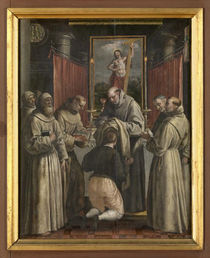The Catholic Defender: Saint Rita of Cascia "Saint of the Impossible"
- Donald Hartley

- May 21
- 4 min read
Updated: May 21
Deepertruth with special permission and aid with Franiciscan Media, a great team for the Lord

Rita is known as the "Saint of the Impossible" because of her amazing answers to prayers, as well as the remarkable events of her own life. Desirous of being a nun, she instead obeyed her parents and married.
“There is nothing impossible to God.” “Most Holy Sacred Heart of Jesus, help my heart to preserve in all that is holy.” “Let me, my Jesus, share in Thy suffering, at least one of Thy thorns.”
Like Elizabeth Ann Seton, Rita of Cascia was a wife, mother, widow, and member of a religious community. Her holiness was reflected in each phase of her life.
Born at Roccaporena in central Italy, Rita wanted to become a nun but was pressured at a young age into marrying a harsh and cruel man. During her 18-year marriage, she bore and raised two sons.
In the parish church of Laarne, near Ghent, Belgium, there is a statue of Rita in which several bees are featured. This depiction originates from the story of her baptism as an infant.
On the day after her baptism, her family noticed a swarm of white bees flying around her as she slept in her crib. However, the bees peacefully entered and exited her mouth without causing her any harm or injury. Instead of being alarmed for her safety, her family was mystified by this sight. According to Butler, this was taken to indicate that the career of the child was to be marked by industry, virtue, and devotion.
Rita was able to convert her husband into a better person,
After her husband was killed in a brawl and her sons had died, Rita tried to join the Augustinian nuns in Cascia. Unsuccessful at first because she was a widow, Rita eventually succeeded.

Over the years, her austerity, prayerfulness, and charity became legendary. When she developed wounds on her forehead, people quickly associated them with the wounds from Christ’s crown of thorns.
She meditated frequently on Christ’s passion. Her care for the sick nuns was especially loving. She also counseled lay people who came to her monastery.
Beatified in 1626, Rita was not canonized until 1900. She has acquired the reputation, together with Saint Jude, as a saint of impossible cases. Many people visit her tomb each year.
When Rita was approximately sixty years of age, she was meditating before an image of Christ crucified. Suddenly, a small wound appeared on her forehead, as though a thorn from the crown that encircled Christ's head had loosened itself and penetrated her own flesh. It was considered to be a partial Stigmata, and she bore this external sign of union with Christ until her death in 1457.
Rita was transported into the monastery of Saint Magdalene via levitation at night into the garden courtyard by her three patron saints. She remained at the monastery, living by the Augustinian Rule, until her death from tuberculosis on 22 May 1457.

At the time of her death, the sisters of the convent bathed and dressed her body for burial. They noticed that her forehead wound remained the same, with drops of blood still reflecting light.
When her body was later exhumed, it was noted that her forehead wound still remained the same, with the glistening light reflected from the drops of blood. Her body showed no signs of deterioration.
Over several years, her body was exhumed two more times. Each time, her body appeared the same. She was declared an incorruptible after the third exhumation.
It is said that near the end of her life Rita was bedridden at the convent.
While visiting her, a cousin asked if she desired anything from her old home.
Rita responded by asking for a rose from the garden. It was January, and her cousin did not expect to find one due to the season.
However, when her relative went to the house, a single blooming rose was found in the garden, and her cousin brought it back to Rita at the convent. St. Rita is often depicted holding roses or with roses nearby. On her feast day, churches and shrines of St. Rita provide roses to the congregation that are blessed by the priest during Mass.
Pope Leo XIII canonized Rita on 24 May 1900. Her feast day is celebrated on 22 May. At her canonization ceremony, she was bestowed the title of Patroness of Impossible Causes, while in many Catholic countries, Rita came to be known as the patroness of abused wives and heartbroken women. Her incorrupt body remains in the Basilica of Santa Rita da Cascia.

Rita is often credited as also being the unofficial patron saint of baseball due to a reference made to her in the 2002 film The Rookie.
Although we can easily imagine an ideal world in which to live out our baptismal vocation, such a world does not exist. An “If only ….” approach to holiness never quite gets underway, never produces the fruit that God has a right to expect.
Rita became holy because she made choices that reflected her baptism and her growth as a disciple of Jesus. Her overarching, lifelong choice was to cooperate generously with God’s grace, but many small choices were needed to make that happen. Few of those choices were made in ideal circumstances—not even when Rita became an Augustinian nun.





















Comments